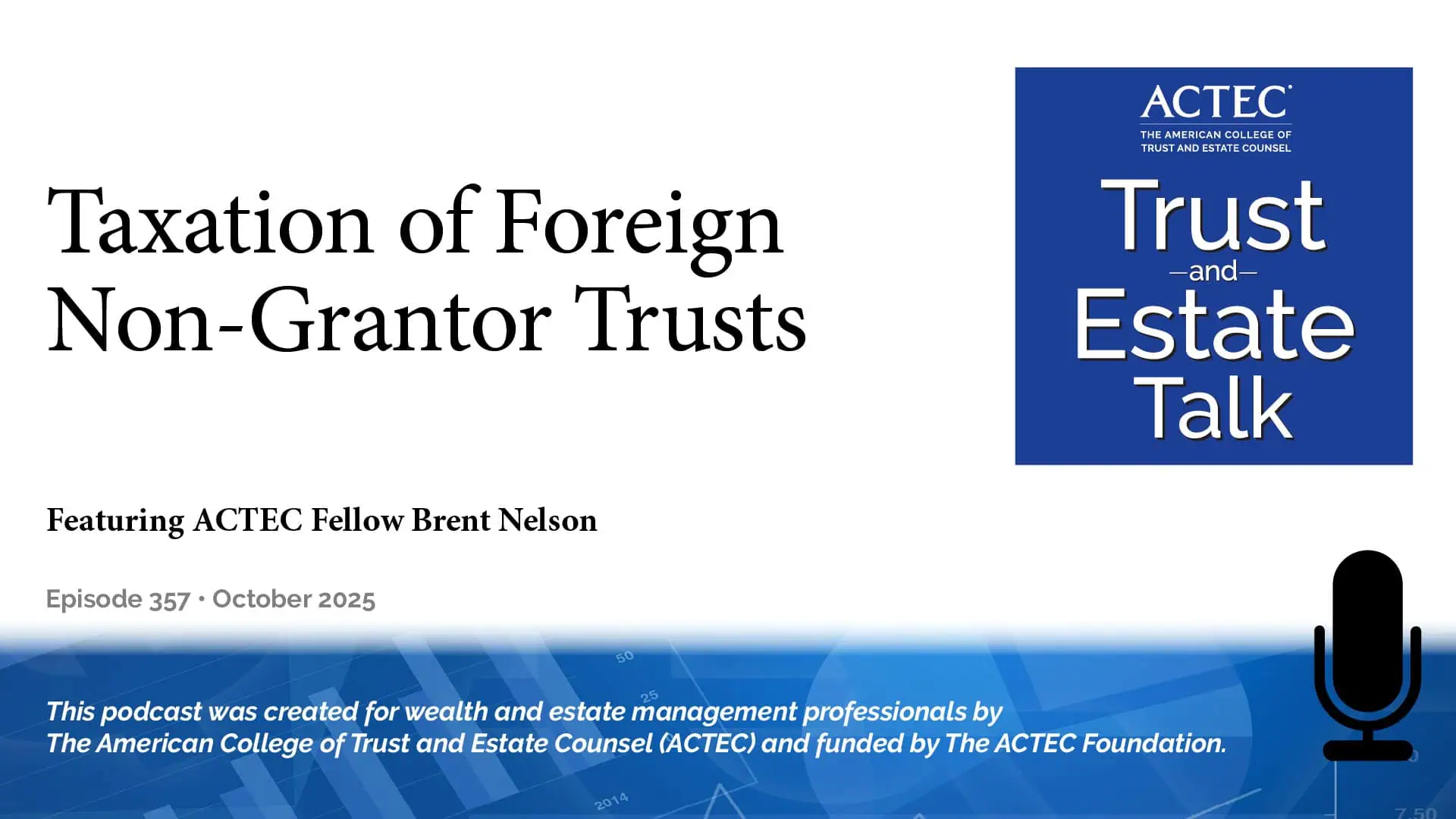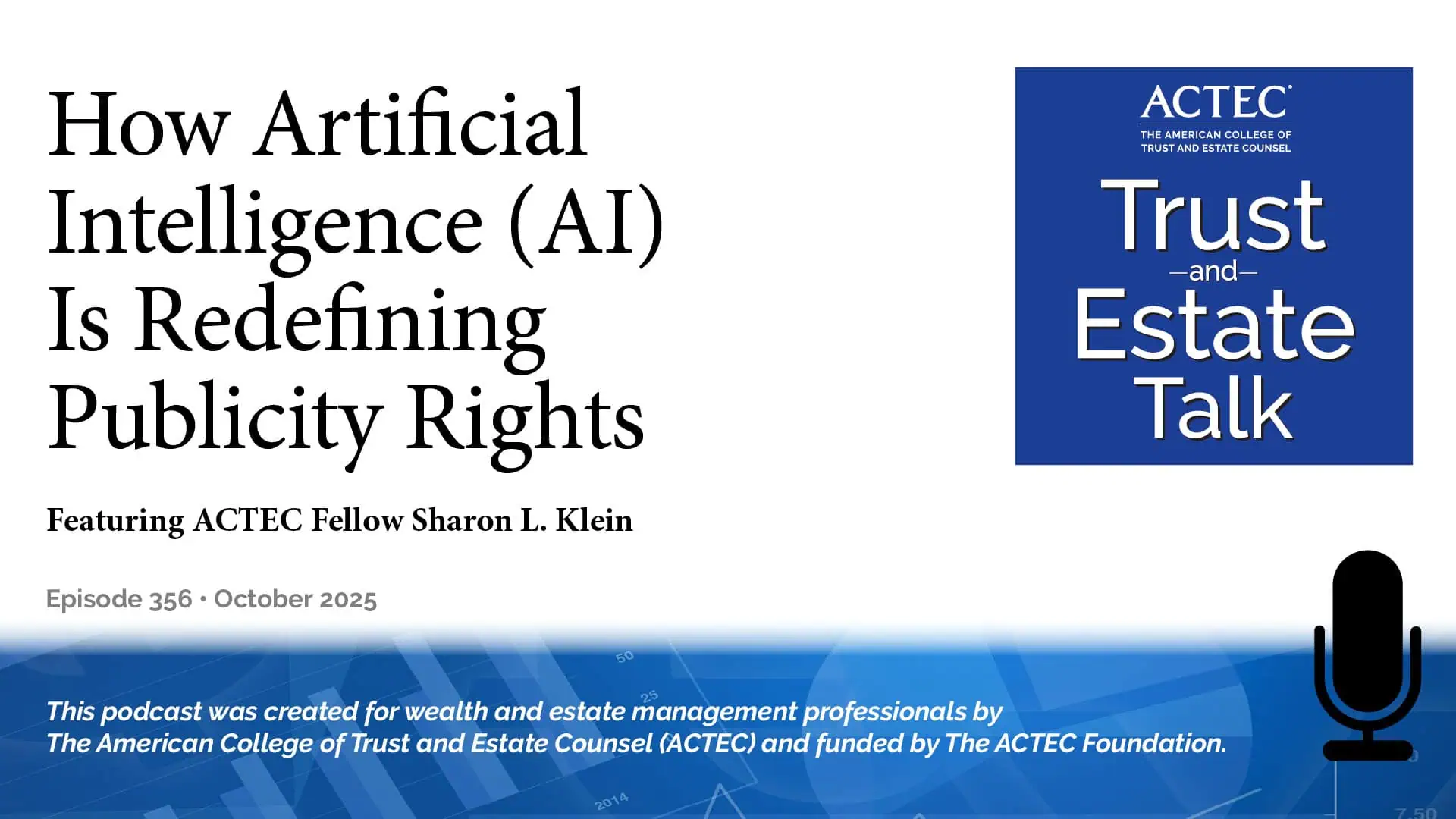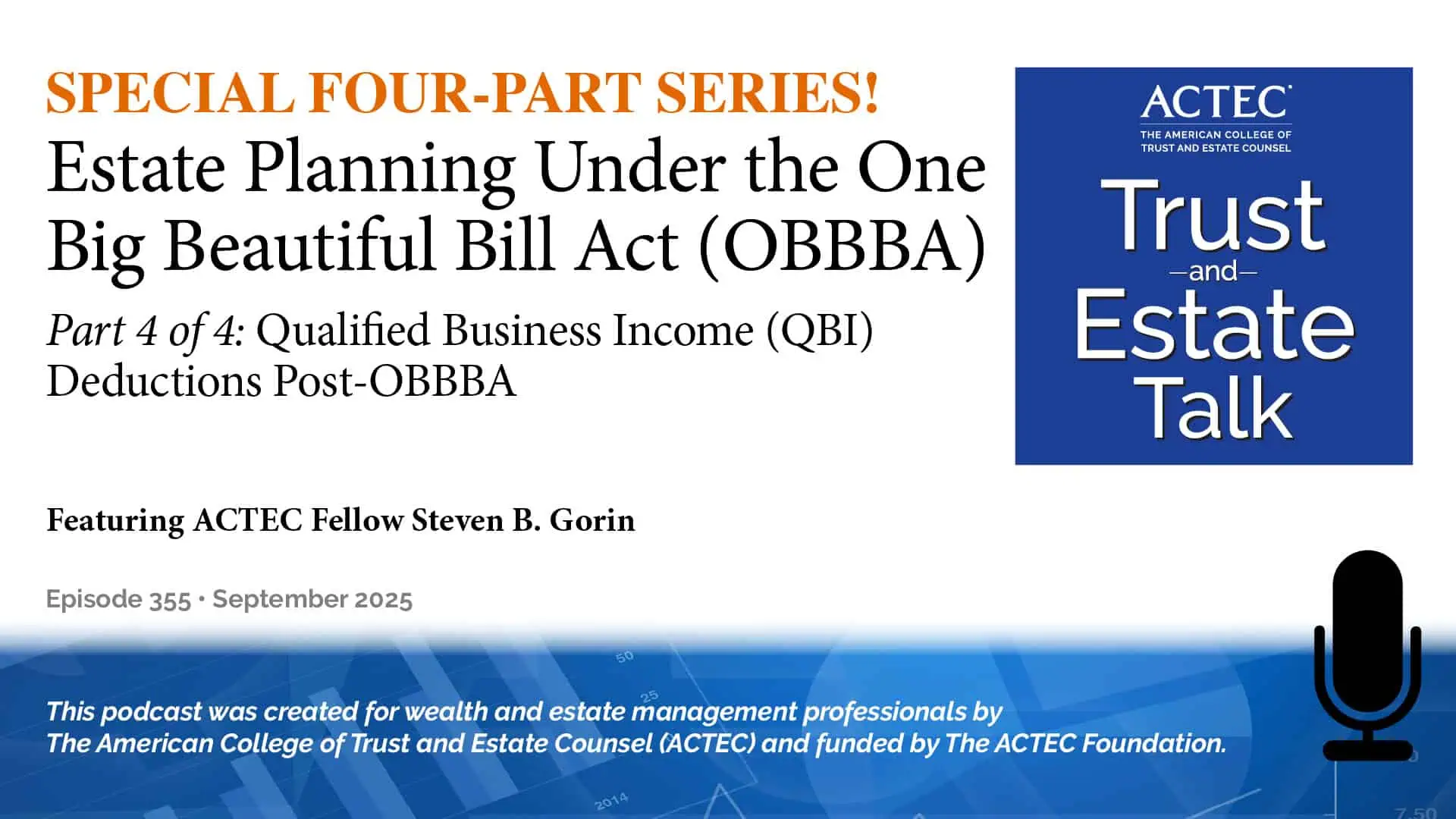Business Entity Income Tax: Regulatory Rigidity Versus Flexibility
“Business Entity Income Tax: Regulatory Rigidity Versus Flexibility,” that is the subject of today’s ACTEC Trust and Estate Talk.
Transcript/Show Notes
This is Ed Beckwith, ACTEC Fellow from Washington, D.C. For federal income tax purposes, the government regulates entities differently. To give us more information on this topic, we’ll be hearing today from ACTEC Fellows, Brian Sparks of Tampa, Florida and Stacy Eastland of Houston, Texas. Welcome Brian and Stacy.
Thank you very much. Well, Stacy, you and I have been at this game for quite a long time and we have seen quite a lot of different types of entities kind of come and go in terms of popularity for estate planning and business planning purposes. We thought it would be useful for our audience to talk a little bit today about how those different entities have evolved in terms of how the government goes about regulating them.
Business Taxes – C Corporation
We start with the C corporation, which probably is the most formalistic type of regulated entity by our federal government. We have pretty strict rules under Subchapter C in terms of how those entities can operate, the types of interest that their owners, shareholders, can have, the consequences of distributions, income, liquidation and so on, and of course C corporations are subject to tax at the corporate level and then in some cases, unless it’s qualified dividends, when those monies then get distributed as either dividends or liquidating distributions out to their shareholders.
Business Taxes – S Corporation
We move on to perhaps a more flexible category, which is the S corporation, which is available as a result of the special election filed with the IRS. S corporations are unlike C corporations. They are treated as pass-through entities. So the income that they recognize at the corporate level flows out and then is recognized by the shareholders at their level without any intervening C corporation taxation, except when our S corporation was a C corporation previously and there are attributes. For example, accumulated earnings in profits attributable to its C corporation years that are still within the S corporation. So, there are special rules there. And as those entities became popular and then they started to wane because we started to pick up using partnerships a lot more.
Business Taxes – Partnerships
Initially, most partnerships in my experience dealing with clients were general partnerships. It was unusual in my early years of practice to have limited partnerships. Those were largely confined to the tax shelter industry, which was truncated quite a bit by the 1986 Tax Act, but then limited partnerships began to get more popular I would say in the 1990’s, and of course in many respects due to the efforts you, Stacy, made as a speaker talking about family limited partnerships and the advantages that they would provide for many families. They then translated into certain enhancements that were enacted largely by the various states to create limited liability partnerships, registered limited partnerships and in my state of Florida, limited liability – limited partnerships. The main gist of that being that the general partner would no longer have unlimited liability exposure but instead would have limited liability exposure just like the limited partners.
Business Taxes – Limited Lability Companies (LLC)
Well, I guess we were not done at that point, we then transitioned over to limited liability companies, which have attributes of C corporations, S corporations and partnerships. On the C corporation side, they had the feature of limited liability. On the S corporation and partnership side, they had passed through entity status for federal income tax purposes and then when the IRS and the Department of Treasury eased up on their entity regulation and allowed it to be largely elective, we were in a situation we continue to be in today, where LLCs can elect to be corporations – taxed as either C corporations or pass-through S corporations or partnerships or even a newfangled entity called the disregarded entity where much like a Grantor Trust: one just ignores the entity and takes its income results for the year and puts it on an individual income tax return.
So, we have quite the alphabet soup and variety of entities with a variety of how the federal government has decided to tax them and how it is decided to regulate those entities and Stacy, I know you have some great thoughts on this.
Business Taxes – Single-Member LLC (Limited Lability Company)
Well, thank you Brian. My favorite entity I guess – it has a lot of flexibility, is a single-member limited liability company that you mentioned, and it has, I think, some exciting basis enhancement possibilities and also has the advantage of the flexibility that you mentioned. So, let me give you an example, if I may. Suppose you have a client that owns subchapter S stock. Also suppose this client owns some C corporation stock. Also suppose this client has some limited partnership investments. What if the client took the limited partnership investments, maybe recapitalized as a subchapter S corporation, so yeah, voting and non-voting stock, and he puts the non-voting stock into a single-member limited liability company along with a limited partnership interest set out — the limited liability company, let me just call it Whole Co., puts it in there, maybe with non-voting stock of the C corporation interest. Now, Whole Co., because the considerations with subchapter S, needs to be worded that it automatically terminates on the death of the client.
What you could do, the traditional way, when these types of assets are put into a single-member limited liability company, is that you get managing and non-managing interest back. The twist of that is, what if in forming this Whole Co., you also get back a note? Now, let us just say that it is a 90 percent leverage, in other words, 90 percent of what you get back is a note. Another twist, what if the note is convertible into that amount of units at any time that the holder wishes to convert it to, and maybe you have a mandatory conversion at death. So, whatever Whole Co. turns into, the note is paid off, with that amount of assets is equal to the then principal of the note. So, we have an indirect way of doing an estate freeze with a subchapter S corporation, which is very hard to do because you cannot have two classes of stock with a subchapter S.
So, let us fast forward. Let us assume that the client that owns the note, and maybe it’s been paid down some, owns some managing interest and non-managing interest, he passes away. Well, now the limited liability company terminates, and when it terminates we have this note. It is converted into this equity interest all happening simultaneously when the client dies. And so, the note could be paid off when this conversion happens. It could be paid off with limited partnership interest; it could be paid off with stock from the subchapter S. In a S Corporation Death Traps, we mentioned the special things you can do at the death, if you get it all done within the year. Partnerships, naturally, you can get a step-up in basis of the inside assets with a subchapter S corporation, we need to do the technique that we mentioned in our prior podcast where you terminate the subchapter S corporation all in the same year of death. We have that liquidation in the same year.
Right. So, it can be an exciting estate planning technique but we are using all this flexibility, but it can also be an exciting basis-enhancing technique and many clients like it just because of the flexibility they have in being able to convert the note at any time, in case they want to get back, as one of my clients put it, back on the trolley and have more of an equity interest of just this liability. So, I have really enjoyed doing the podcast with you Brian, I don’t know if you have any further observations.
Well, same here Stacy. Thank you very much. I think this short, little discussion exemplifies how much rigidity and flexibility we have in the various types of business entities that we can use for our clients in structuring their business affairs so that we can maximize what they want to try and get out of the entities but avoid tax traps down the road with the type of planning that we are doing. So, thanks again.
Thank you.
Thank you, Brian, and thank you, Stacy, for sharing this important information.
If you have ideas for a future ACTEC Trust & Estate Talk topic, please contact us at ACTECpodcast@ACTEC.org.
© 2018 – 2025 The American College of Trust and Estate Counsel. All rights reserved.
Latest ACTEC Trust and Estate Talk Podcasts

Taxation of Foreign Non-Grantor Trusts
Learn how U.S. tax rules affect foreign non-grantor trusts and discover key strategies for cross-border estate planning and compliance.

How Artificial Intelligence (AI) Is Redefining Publicity Rights
Explore how AI, deepfakes, and digital replicas are reshaping publicity rights, estate planning, and legacy protection.

Qualified Business Income (QBI) Deductions Post-OBBBA
Learn how the One Big Beautiful Bill Act changes the Qualified Business Income (QBI) Deduction, expanding phase-in ranges and tax planning opportunities.



